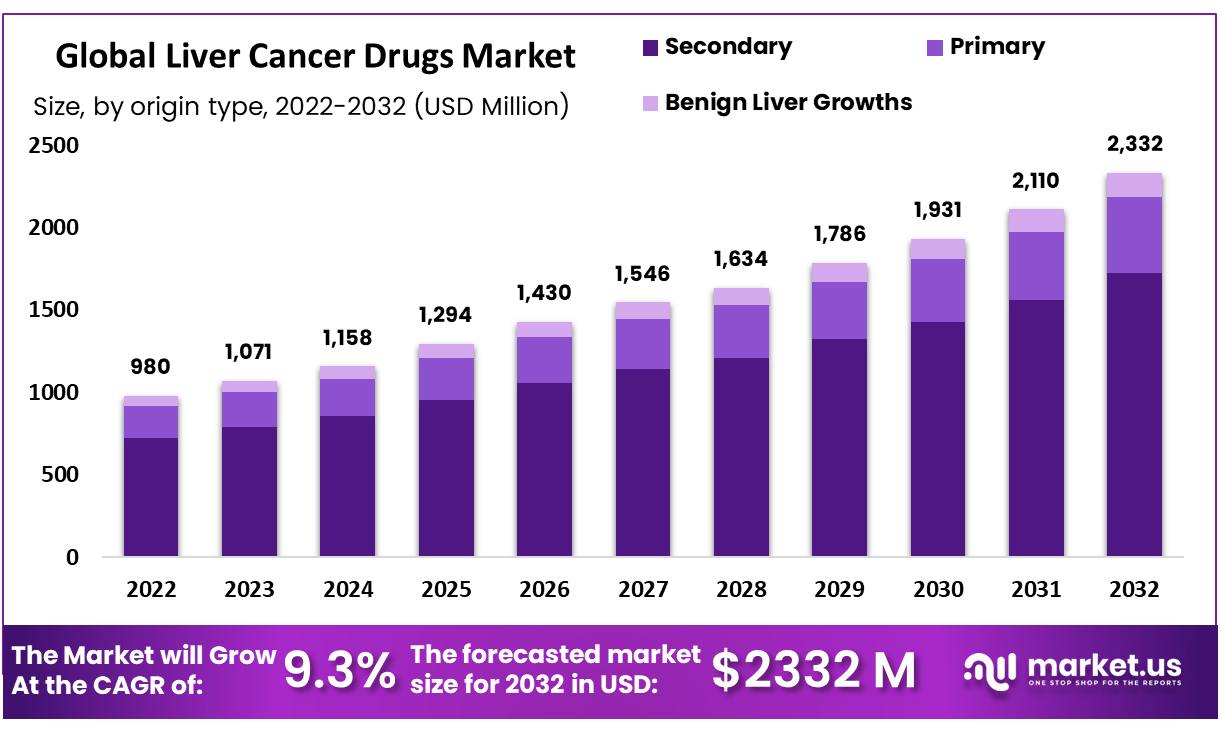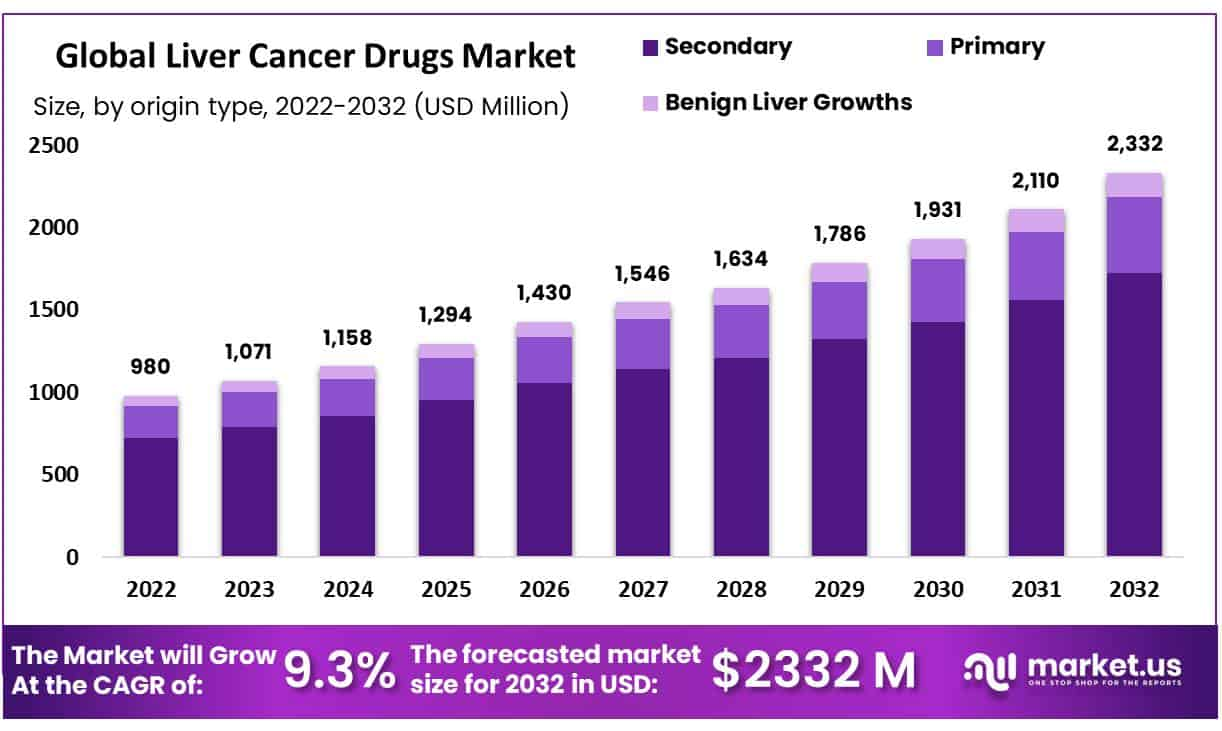The global liver cancer drugs market is projected to reach USD 2,332 million by 2032, up from USD 980 million in 2022. This reflects a strong CAGR of 9.3% from 2023 to 2032. One of the major drivers of this growth is the rising global incidence of liver cancer. According to the World Health Organization (WHO), liver cancer was responsible for over 800,000 deaths in 2022. It ranks as the third leading cause of cancer-related deaths. This alarming figure highlights the urgent need for more effective treatment options, boosting demand for liver cancer drugs worldwide.
A major contributor to liver cancer cases is the increasing prevalence of chronic hepatitis B and C infections. These infections cause long-term liver damage and are a well-known risk factor for liver cancer. The Centers for Disease Control and Prevention (CDC) stresses that people with untreated hepatitis B or C have a significantly higher chance of developing liver cancer. As diagnoses of these infections grow globally, the demand for effective treatment drugs continues to rise, further fueling market expansion.
Government-led screening programs and awareness campaigns are also improving early diagnosis rates. Many countries, such as Japan and South Korea, have implemented national programs that encourage regular screening for liver disease. These initiatives allow for early detection and timely intervention, increasing the use of liver cancer medications. Public health organizations are also promoting liver health awareness, which helps in reducing late-stage diagnoses and improves treatment outcomes.
Research and development investments are supporting the introduction of advanced treatment options. Public health agencies like the U.S. National Cancer Institute (NCI) and similar institutions in Europe and Asia are funding clinical trials for new drugs. This increased focus on innovation is leading to the development of more effective and targeted therapies. As a result, pharmaceutical companies are able to introduce better drugs with fewer side effects, further driving market growth.

Key Takeaways
- Liver cancer, also known as hepatic carcinoma, ranks among the top six most common cancer types globally, requiring targeted and immunotherapy-based treatments.
- The global liver cancer drugs market was valued at USD 980 million in 2022 and is projected to grow at a 9.3% CAGR by 2032.
- Market growth is driven by increasing liver cancer cases, improved diagnostics, and the emergence of novel immunotherapy-based treatment options.
- Chronic hepatitis infections, especially Hepatitis B and C, remain among the leading risk factors associated with liver cancer worldwide.
- North America led the liver cancer drugs market in 2021 due to high awareness, better screening, and early diagnosis rates.
- Asia Pacific is expected to record the fastest growth due to increasing liver cancer prevalence and rising healthcare access during the forecast period.
- Nexavar, developed by Bayer, currently holds the highest market share as the most widely used liver cancer medication.
- Immunotherapy drugs like Opdivo and Keytruda are gaining rapid momentum and are expected to significantly boost their presence in the market.
GET SAMPLE REPORT : https://market.us/report/liver-cancer-drugs-market/request-sample/
Use Cases
1. First-Line Treatment for Advanced Liver Cancer
Many patients with advanced liver cancer cannot undergo surgery. In such cases, doctors often start treatment with drugs like Sorafenib (Nexavar) or Lenvatinib (Lenvima). These medications are used as first-line therapy, meaning they are the first option after diagnosis. They help slow the cancer's growth and improve how patients feel. These drugs do not cure liver cancer, but they can extend survival and maintain quality of life. Regular monitoring is required to track progress. Patients may also get supportive care to manage symptoms and side effects. First-line treatments play a key role when the disease is inoperable.
2. Second-Line Therapy After Initial Treatment Fails
Sometimes, the first treatment stops working, or it causes too many side effects. In this case, doctors move to second-line therapy. This means giving the patient another medicine to continue fighting cancer. Drugs like Regorafenib (Stivarga) or Cabozantinib (Cabometyx) are commonly used. These drugs can help slow down the cancer again. Second-line therapies offer hope when first-line treatments no longer work. Patients are closely watched to check how they respond. Switching to these drugs can help patients live longer and manage symptoms better. Choosing the right second-line option depends on the patient’s health and treatment history.
3. Immunotherapy for Boosting the Immune System
Some drugs help the body fight liver cancer by using the immune system. This is called immunotherapy. Drugs like Nivolumab (Opdivo) and Pembrolizumab (Keytruda) are examples. These treatments help the body recognize and attack cancer cells. Immunotherapy is often used when other drugs do not work well. It is also useful for patients who cannot handle standard chemotherapy. These drugs may not work for everyone, but some patients see good results. Doctors run tests to see if a patient is a good fit for immunotherapy. Side effects are usually mild compared to traditional treatments.
4. Targeted Therapy Based on Genetic Markers
Liver cancer cells sometimes have special changes called genetic mutations. Doctors can test tumors to find these changes. Then they use drugs that target the specific mutation. This is called targeted therapy. These treatments work more precisely and cause fewer side effects. Patients with known genetic markers may respond better to this type of drug. Targeted therapies can block the growth of cancer by focusing on certain proteins. This approach helps personalize care for each patient. The treatment is based on science and lab tests. It gives patients more options beyond standard drugs.
5. Combination Therapy for Better Results
Sometimes, using two drugs together gives better results than one drug alone. This is called combination therapy. A common mix is Atezolizumab plus Bevacizumab. This combo includes an immunotherapy drug and a targeted therapy. It works by attacking cancer in two ways. Many patients see better results with this combination than with standard treatments. It can help slow tumor growth and improve survival. Doctors choose this option based on the patient’s health and cancer stage. Regular monitoring helps ensure the treatment is working. Side effects are managed carefully to keep the patient comfortable.
Conclusion
In conclusion, the liver cancer drugs market is growing steadily due to rising global cases and better access to diagnosis and treatment. Increased awareness, early screening, and the growing use of advanced therapies like immunotherapy and targeted treatments are supporting this growth. Chronic hepatitis infections continue to be a major cause of liver cancer, pushing demand for more effective drugs. With governments promoting early detection and pharmaceutical companies investing in research, patients now have more treatment options than ever before. The development of combination therapies and precision medicine also offers new hope.

